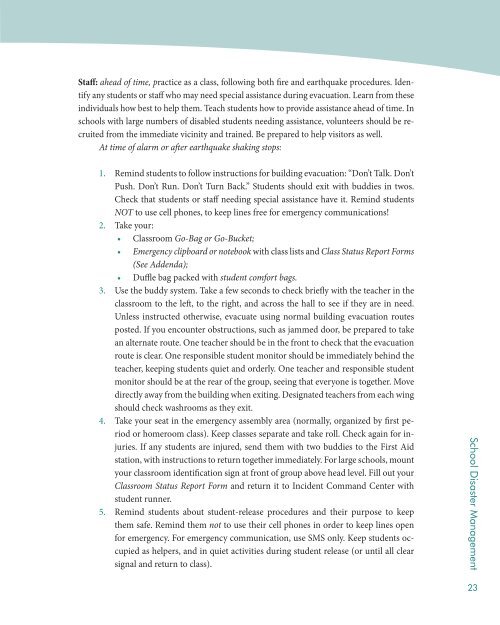Disaster and Emergency Preparedness: Guidance for ... - INEE Toolkit
Disaster and Emergency Preparedness: Guidance for ... - INEE Toolkit
Disaster and Emergency Preparedness: Guidance for ... - INEE Toolkit
Create successful ePaper yourself
Turn your PDF publications into a flip-book with our unique Google optimized e-Paper software.
Staff: ahead of time, practice as a class, following both fire <strong>and</strong> earthquake procedures. Identifyany students or staff who may need special assistance during evacuation. Learn from theseindividuals how best to help them. Teach students how to provide assistance ahead of time. Inschools with large numbers of disabled students needing assistance, volunteers should be recruitedfrom the immediate vicinity <strong>and</strong> trained. Be prepared to help visitors as well.At time of alarm or after earthquake shaking stops:1. Remind students to follow instructions <strong>for</strong> building evacuation: “Don’t Talk. Don’tPush. Don’t Run. Don’t Turn Back.” Students should exit with buddies in twos.Check that students or staff needing special assistance have it. Remind studentsNOT to use cell phones, to keep lines free <strong>for</strong> emergency communications!2. Take your: Classroom Go-Bag or Go-Bucket; <strong>Emergency</strong> clipboard or notebook with class lists <strong>and</strong> Class Status Report Forms(See Addenda); Duffle bag packed with student com<strong>for</strong>t bags.3. Use the buddy system. Take a few seconds to check briefly with the teacher in theclassroom to the left, to the right, <strong>and</strong> across the hall to see if they are in need.Unless instructed otherwise, evacuate using normal building evacuation routesposted. If you encounter obstructions, such as jammed door, be prepared to takean alternate route. One teacher should be in the front to check that the evacuationroute is clear. One responsible student monitor should be immediately behind theteacher, keeping students quiet <strong>and</strong> orderly. One teacher <strong>and</strong> responsible studentmonitor should be at the rear of the group, seeing that everyone is together. Movedirectly away from the building when exiting. Designated teachers from each wingshould check washrooms as they exit.4. Take your seat in the emergency assembly area (normally, organized by first periodor homeroom class). Keep classes separate <strong>and</strong> take roll. Check again <strong>for</strong> injuries.If any students are injured, send them with two buddies to the First Aidstation, with instructions to return together immediately. For large schools, mountyour classroom identification sign at front of group above head level. Fill out yourClassroom Status Report Form <strong>and</strong> return it to Incident Comm<strong>and</strong> Center withstudent runner.5. Remind students about student-release procedures <strong>and</strong> their purpose to keepthem safe. Remind them not to use their cell phones in order to keep lines open<strong>for</strong> emergency. For emergency communication, use SMS only. Keep students occupiedas helpers, <strong>and</strong> in quiet activities during student release (or until all clearsignal <strong>and</strong> return to class).School <strong>Disaster</strong> Management23
















